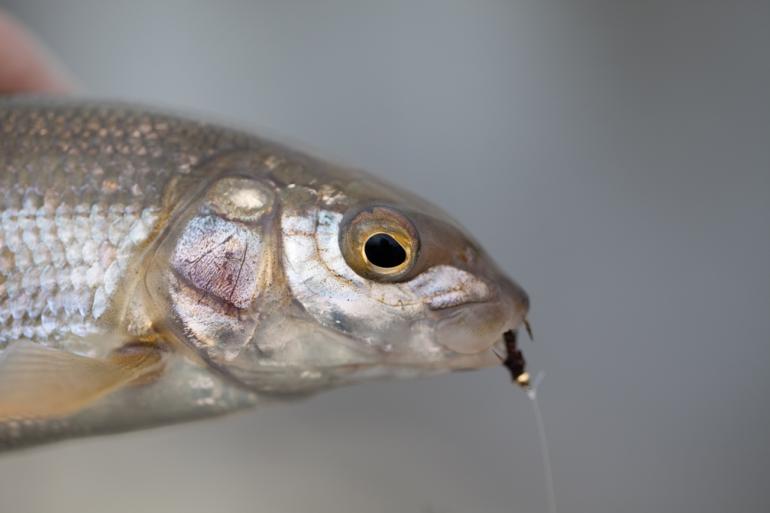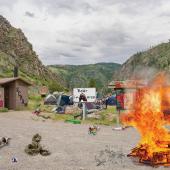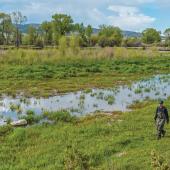Bienvenidos, Señor Blanco
In a rapidly growing western landscape, the ability to assimilate into the local culture is a skill and even a gift. There are certain cultural norms, such as driving through small towns like Gardiner with your steering hand high on the wheel, ready to greet passersby with the customary index-finger salute. These are small things that help make Montana, well, Montana. Likewise, any young angler growing up under the Big Sky will likely be taught about the inferior fish with the pea-shaped mouth and silver body—the mountain whitefish, or Señor Blanco. Often described as the Rodney Dangerfield of the river community, it's considered a trash fish by many anglers.
Many newcomers are shocked to learn of the corresponding “Montana handshake,” which refers to the practice of squeezing the mountain whitefish’s air bladder, and of the famous “bank release,” which refers to the simple—albeit illegal—act of tossing whitefish onto the riverbank to suffocate slowly. Sadly, newcomers quickly learn to accept this discriminatory philosophy toward one of Bozeman's most common and abundant fish species.
The typical argument for the Montana handshake is that the mountain whitefish competes with trout for food. This naively ignores the fact that both species have evolved over thousands of years in the same streams. (It should also be noted that both rainbow and brown trout—the whitefish’s most common “competitors”—were introduced to southwest Montana, while whitefish are native.) Señor Blanco not only serves as a “canary in the coal mine”—indicating the health of our rivers and streams—but it also eagerly eats a beadhead nymph. As a guide and director of the River Guardian Fly Fishing School, which serves high schoolers across Gallatin and Park County, I've witnessed the joy and excitement novice anglers feel when they hook a feisty whitefish.
Although the mountain whitefish may not leap and routinely rip line off your reel the way rainbows and browns do, no one can contend that this vigorous member of the trout family—yep, that's right, Señor Blanco has trout bloodlines—doesn’t put up a good fight. Every time new clients climb aboard my drift boat, the first thing I do after a brief casting tutorial is tell them I have one rule: “All finned friends are treated equally, meaning we will wet our hands and gently release every member of the finned community we have the opportunity to meet today.”
And yet hardly a summer day goes by on the waters of Yellowstone Country without an obsessive-compulsive fly fisherman exclaiming, “Damn! It’s just a freakin’ whitefish.”
The mountain whitefish has been maligned for far too long. Maybe it’s everybody’s tendency to overlook their iridescent bodies, or maybe it’s the perceived ease of catching this abundant species. Maybe it’s the rosy gill plate, pea-shaped mouth, and higher oil content leading to a slightly fishier smell. But regardless of the reason, it’s time for a whitefish revolution.
In order to change this outdated cultural norm, we must redefine what is desirable and what is not. Sexy is in the eye of the beholder, after all. So next time you land a mountain whitefish, leave the “it’s just a whitey” jargon at home and show some respect to Señor Blanco.
Ol' Smokey
As the old joke goes, whitefish are great smoked, but they’re hard to keep lit. That’s right: smoked whitefish—something many fisher folk have heard of but have never actually tried. Any traditional charcoal barbeque will do; the only benefit of an electric smoker is the ability set the temperature, time, and forget about it. I find the traditional method better because it oftentimes results in better table fare.
Ingredients:
2-3 larger (12 inches or better) whitefish filleted and boned. (Approx. 3-5 lbs)
1 gallon water
1 1/3 cups canning salt
2/3 cup brown sugar
Directions:
Mix the salt and sugar with the water until it is all dissolved. (For more flavor, add teriyaki, bourbon, honey, or some Old Bay—get creative.) Totally submerge the fillets and let them soak for at least 12 hours. Prep your smoker using a mixture of charcoal and alder wood—apple, hickory, or mesquite also work. Soak some of the chips in water for about an hour. This cools the coal bed and provides a richer, cooler smoke; don’t forget to drain these chips before you add them to the coals. Spread the glowing red coals evenly out in the smoker. Once you have a good bed of coals, add the soaked chips. Place the fish on the grate in the smoker. Spray your grate with cooking spray to keep the fish from sticking. Smoke the fish for 6 to 8 hours, remembering to check regularly. Smoking time will vary depending on your smoker and the outside temperature, but once the fish is flakey, remove the fillets, let cool, and enjoy. Smoked whitefish can be enjoyed on a cracker cocktail-style, mixed with scrambled eggs for breakfast, or added to a chowder for a hearty dinner.
—Kurt Dehmer












